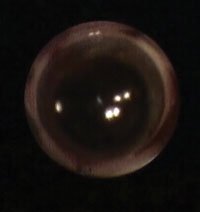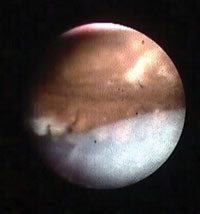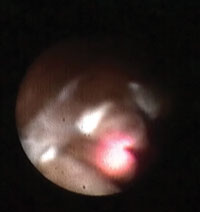Endocycloplasty shows promise for treating plateau iris syndrome
This new technique is derived from endoscopic cyclophotocoagulation.
Angle-closure glaucoma is most commonly due to relative pupillary block in which retro-iris aqueous pressure forces the iris anteriorly. A less common type of angle-closure glaucoma is called plateau iris syndrome, which is more common among women who are 30 to 50 years old, are hyperopic, and often have a family history of angle-closure glaucoma. Angle closure in plateau iris may be spontaneous or may result from pupillary dilation. In plateau iris syndrome, a large or anteriorly placed ciliary process pushes the peripheral iris tissue forward against the trabecular meshwork, crowds the angle and blocks aqueous outflow, resulting in angle-closure glaucoma. The central anterior chamber depth may appear normal on biomicroscopy, while gonioscopy often reveals crowding or closure of the iridocorneal angle.
The iris has a flat approach on a plane to intersect Schwalbe’s line, with a steep drop-off just before the trabecular meshwork. Indentation gonioscopy may reveal a sine wave or double-hump sign, in which the distal hump is secondary to the iris draping over the anteriorly placed ciliary body and the proximal hump is due to the iris curving over the anterior lens surface. Often cataract extraction does not favorably alter the angle anatomy in these cases of plateau iris syndrome. In addition to gonioscopy, both ultrasound biomicroscopy and optical coherence tomography provide useful anatomic information in making the diagnosis of plateau iris syndrome.
Plateau iris treatment is primarily surgical. Some patients with plateau iris frequently have a component of pupillary block, and peripheral laser iridotomy can be beneficial. However, persistent occludable angle in the presence of a patent iridotomy requires further surgical intervention such as laser iridoplasty. Pilocarpine may facilitate opening of the angle in some cases. Failed laser iridoplasty may require trabeculectomy or a tube shunt in some cases.
In this column, Dr. Francis describes his surgical technique of endocycloplasty during conventional cataract surgery for plateau iris.
Thomas John, MD
OSN Surgical Maneuvers Editor
by Brian A. Francis, MD, MS

Brian A. Francis
Plateau iris syndrome is characterized by a persistently narrow angle despite a patent iridotomy. In most patients with narrow angle configuration, an iridotomy widens the angle and reduces pupillary block. However, in plateau iris, the angle remains narrow and a “double hump” is seen on gonioscopy. This is due to anteriorly positioned ciliary processes, which push the peripheral iris forward. This syndrome can lead to chronic angle-closure glaucoma. The exact prevalence of plateau iris is unknown. However, it reportedly accounts for more than half of young patients with recurrent angle closure.
The most common treatment is argon laser peripheral iridoplasty. This consists of placing large laser burns on the peripheral iris, which compacts the iris tissue and draws it away from the trabecular meshwork. However, it does not directly address the issue of the anteriorly positioned ciliary processes. Endocycloplasty (ECPL) is a new technique, derived from endoscopic cyclophotocoagulation (ECP), that has shown promising results.
Regular ECP usually tries to treat as much of the ciliary epithelium as possible, treating the anterior processes first and moving them anteriorly so that we can treat more. In ECPL, we treat each process individually to shrink it posteriorly and move it away from the iris. In order to accomplish this, we want to treat the posterior aspect of the processes first in order to shrink it posteriorly away from the iris, as opposed to standard ECP.Surgical procedure
I begin with standard cataract surgery, removing the natural lens and implanting the IOL. Once the IOL is in place, I remove the viscoelastic from the capsular bag and place viscoelastic inside the anterior chamber and the ciliary sulcus to create space for the endoscopic probe. This also pushes the lens posteriorly and the iris anteriorly, allowing the surgeon to see the ciliary processes. Using the E2 diode laser endoscope system (Endo Optiks), I perform ECPL at a power of 0.3 W on a continuous setting. These laser settings are the same as ECP and are not pulse laser applications.

View from the endoscopic probe before entering the eye.

View of the angle where endoscopic cyclophotocoagulation will be applied.


Dr. Francis lasers in a "paintbrushing" style as opposed to one brief burst. With ECP he uses the laser in a constant longer pattern.
Images: Francis BA
Using a spray-painting technique, I hold the pedal down and paint the processes with the diode laser, starting at the posterior, or middle, of the process. This tends to pull the anterior process posteriorly, away from the iris. This is continued between 270° and 360° around the eye. Once it is complete, irrigation and aspiration is conducted, and then I typically suture my incisions. The procedure is concluded with a steroid given subconjunctivally, and 600 µg of preservative-free dexamethasone can be injected into the anterior chamber as well if inflammation is predicted to be an issue.
Discussion
It has been proposed that simply removing the natural lens would open the angle and make a difference. However, we have found that this is not the case. A study by Ritch and colleagues used ultrasound biomicroscopy to analyze the eye before and after cataract extraction and found that post-extraction patients still had narrow angles and that the ciliary processes were still touching the posterior iris surface.
With ECPL, the treatment is targeted specifically to what is believed to be the anatomical abnormality, the large ciliary processes that are pushing forward onto the iris. We used ultrasound biomicroscopy to delineate parameters to detail plateau iris syndrome such as ciliary process thickness, width and area, as well as the contact length between the ciliary processes and the posterior iris surface. After ECPL, we have found a significant decrease in the size of the ciliary processes, as well as a significant increase in the anterior chamber angles. We also found that while the ciliary processes were smaller and flattened out, the technique did not rotate the angle of anterior rotation.
Conclusion
Severe plateau iris syndrome manifests with a unique positioning of the ciliary processes, thus requiring a novel treatment approach. Iridotomy is not a successful treatment option. Iridoplasty has better outcomes, but the effects are temporary and do not work in everyone. With ECPL, we are attacking the anatomic part of the problem — the large, anteriorly rotated processes — and so far the results are showing that it works well.
References:
- Ritch R, Tham CC, Lam DS. Long-term success of argon laser peripheral iridoplasty in the management of plateau iris syndrome. Ophthalmology. 2004;111(1):104-108.
- Stieger R, Kniestedt C, Sutter F, Bachmann LM, Stuermer J. Prevalence of plateau iris syndrome in young patients with recurrent angle closure. Clin Exp Ophthalmol. 2007;35(5):409-413.
- Tran HV, Liebmann JM, Ritch R. Iridociliary apposition in plateau iris syndrome persists after cataract extraction. Am J Ophthalmol. 2003;135(1):40-43.
For more information:
- Brian A. Francis, MD, MS, can be reached at Doheny Eye Institute, 1450 San Pablo St., Suite 4804, Los Angeles, CA 90033; 323-442-6454; email: bfrancis@usc.edu.
- Thomas John, MD, is a clinical associate professor at Loyola University at Chicago and is in private practice in Oak Brook, Tinley Park and Oak Lawn, Ill. He can be reached at 708-429-2223; fax: 708-429-2226; email: tjcornea@gmail.com.
- Disclosure: Dr. Francis is on the medical advisory board for Endo Optiks. Dr. John has no relevant financial disclosures.
